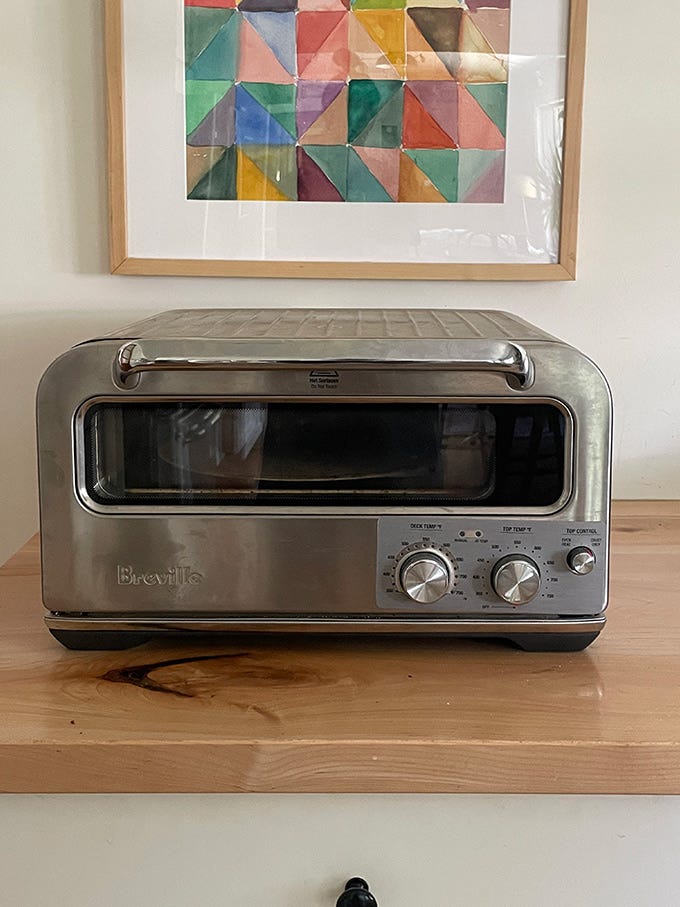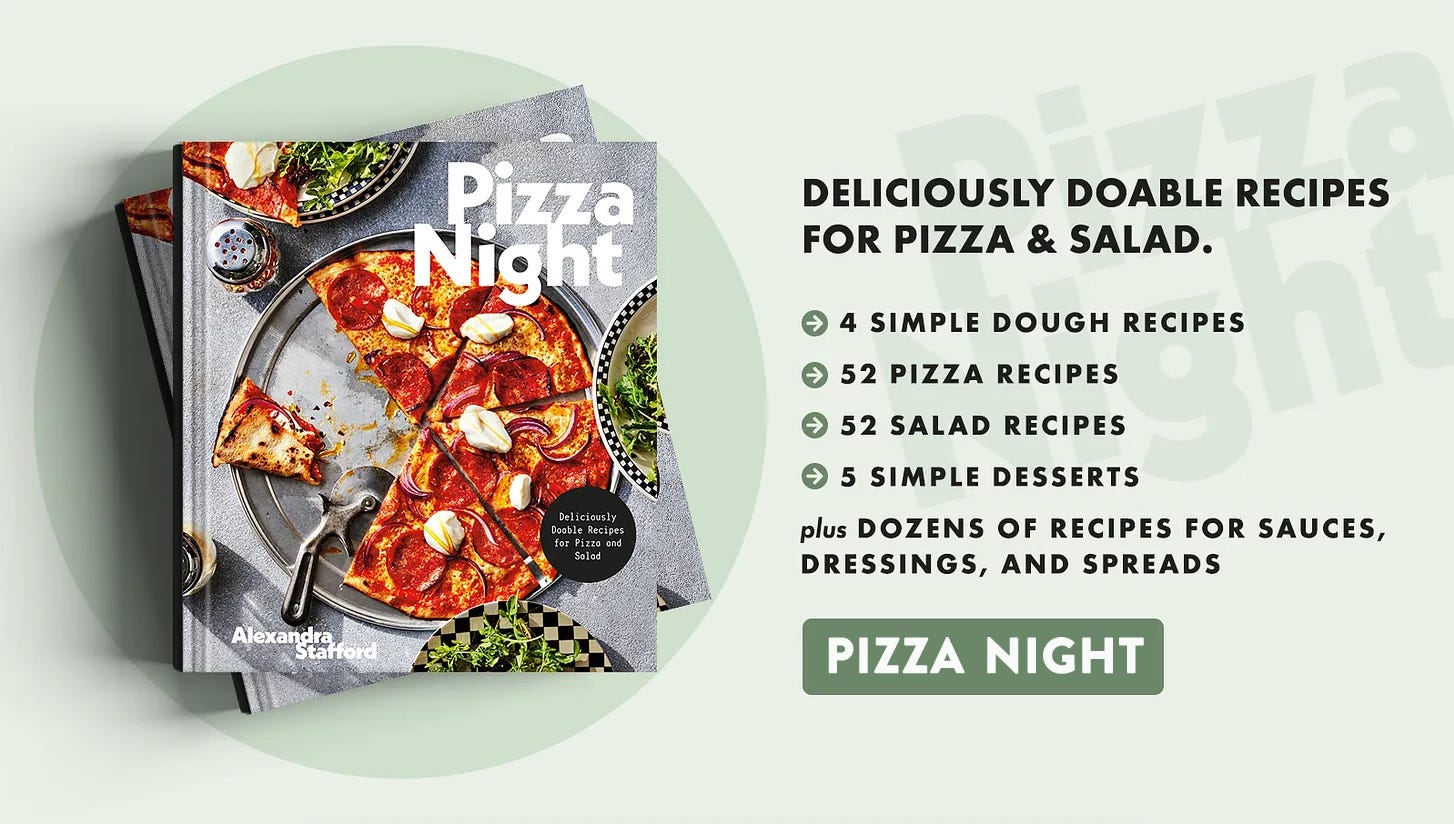A Review of the Breville Pizzaiolo
Plus: Summer Squash Pizza with Garlic Confit, Basil & Burrata
Hello Pizza Friends,
Last week while trying to shoot a video of a pizza cooking in my Gozney Dome, my phone shut off due to the extreme temperature. It was 107ºF outside (or felt that way anyway with the humidity) and between the sun and the heat emanating from the Dome, my phone couldn’t handle it.
While this likely would not have happened yesterday, the high temperature still gave me pause, and so I opted to use my Breville Pizzaiolo, a countertop electric oven, which I have been meaning to review here for months anyway.
With summer squash in the fridge along with an open tin of anchovies and a boodle of basil on the counter, the stars were aligning for a favorite pizza, zucchini pie, from Jim Lahey’s My Pizza. I added garlic confit, which I made for the first time this week — it’s surprisingly easy and makes your house smell heavenly — and I loved the sweetness the buttery, caramelized cloves lent to the pie.
Below you will find a brief review of the Breville Pizzaiolo as well as a how-to video, in which I show how to use the oven in “manual mode”, the settings to use for Neapolitan-style pizza, and how to make the above-pictured summer squash pizza.
Stay cool, my Friends! Next week, I’m heading to Minnesota with my family to see some friends, and it is very unlikely I will be able to put together a post before leaving. Alas. See you in two weeks. Happy Fourth!
Video: Summer Squash Pizza Made in the Breville Pizzaiolo
Review: Breville Pizzaiolo
I purchased the Breville Pizzaiolo after watching a YouTube video starring Anthony Falco, a pizza consultant, who sang the oven’s praises.
At this point, I did not own an outdoor pizza oven, and I loved the idea of being able to make a more true Neapolitan-style pizza at home. From what I watched and read online, the Pizzaiolo looked promising, a device that could churn out a leopard-spotted, poofy-crusted pizza in under 2 minutes.
As has been my experience with so many of these sorts of ovens, learning to use this one required some practice, and I made a handful of burnt, doughy, mangled pizzas before I found a method that worked.
Let’s jump right in. This is what works for me:
Using Manual Mode: The two default dials on the oven are “timer” and “style”. “Timer” is self-explanatory. “Style” includes settings for “pan”, “New York,” “thin-and-crispy”, “wood-fired”, etc. But I prefer to use “manual mode” — I show how to switch to manual mode in the video above — which gives you more control over the “deck” and “top” temperatures. Every time I use my Pizzaiolo, I refer to these two photos in the manual:
Using a dough with a lower hydration. When cooking pizza at a higher temperature, you need to use a lower-hydration dough (see this post for a review as to why). With the Breville Pizzailo at its hottest setting, a 70% hydration dough works great.
Using slightly smaller dough balls. Because the space is so small (12 inches in diameter), a smaller-sized dough ball (220 grams) cooks a little bit better than the typical size I use. That said, in the video above, I did not scale down my dough balls, and they worked fine — they were roughly 238 grams each.
Using parchment paper + semolina. I love these rounds both for my home oven pizzas and Pizzaiolo pizzas. They are particularly helpful with this oven for two reasons: 1. They are 12 inches in diameter, which is the exact size of the Pizzaiolo’s stone. 2. They make the transfer to the oven seamless — as noted above, the cooking space is so small and there is little room for error. The paper will char slightly but it will not catch fire. Based on a comment below, using semolina further ensures your dough won’t stick to the parchment paper. I always use semolina, because my kids like the texture, and it also helps with the dough not sticking.
Overall, I am very pleased with the results the Pizzaiolo gives for Neapolitan-style pizza, which is the only style of pizza I have made in this oven. So while I can’t really comment on how it performs with other styles of pizza, for me, the only reason to buy this oven would be to make Neapolitan-style pizza — you can make excellent pan pizza in your home oven because you don’t need it to get blazing hot, and the Pizzaiolo is way too small to make a true New York-style pizza.
Positives:
Preheats more quickly than a home oven.
Gets hotter than a home oven.
Makes excellent Neapolitan-style pizza in 3 minutes or less.
Negatives:
Small cooking area.
Large size: I store mine in the basement because I find it to be too bulky to keep out on the countertop all the time.
Loud. It’s not as loud as my wall ovens, but it’s still on the loud side.
The Recipe:
For this pizza, you’ll need summer squash, garlic (confit or raw), crushed red pepper flakes, anchovies (optional but delicious), basil, and burrata:
Garlic confit is surprisingly easy to make: place garlic in a pot with olive oil; cover; bake at 250ºF for 2 hours.
You’ll slice the squash thinly, ideally on a mandoline, then you’ll salt it and let it drain briefly to draw out some of its moisture. You’ll bake the pizza with the garlic confit, anchovies, crushed red pepper flakes, and squash…
… and out of the oven, you’ll top it with burrata and basil.
So summery!
Love pizza and salad? Find recipes, tips, and tricks in Pizza Night 🍕🍕🥗🥗
Amazon | Barnes and Noble | Books-a-Million | Bookshop.org | Hudson Booksellers | Walmart
















This looks delicious and I can’t wait to try it! Would love to know where you got those storage containers for your dough balls and the wood board you cut the pizza on! Thanks!
I have two outdoor pizza ovens, and had no interest in the Breville, mostly because of its $1,000 price tag. But, I was at Sur La Table, and my store had a Breville floor model “as is” for only $700. I also had a 20% off coupon for any item in the store. The new—albeit out-of-box—Breville would set me back only $590. A steal. I couldn’t resist, and I grabbed it.
I would add that it comes with a carbon steel pan for making pan pizzas. Setting the Breville to 650 deck and 600 top makes for an ultra light, ultra crispy pan pizza that cannot be achieved in a home oven at 550. The extra heat makes a big difference.
I’ve even experimented making pan pizzas at 700 with good success, and again, it makes for an ultra light, heavenly pan pizza.